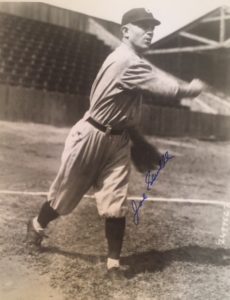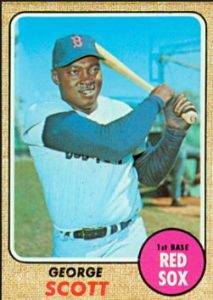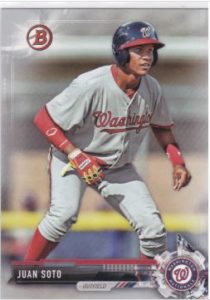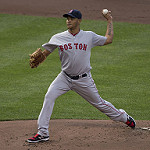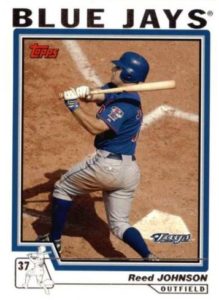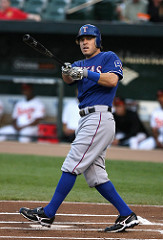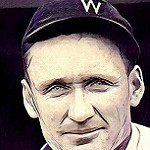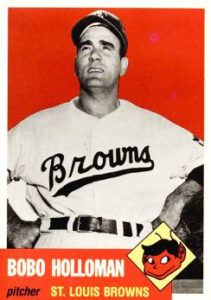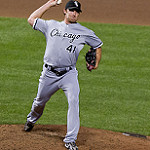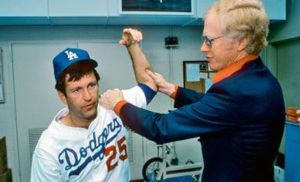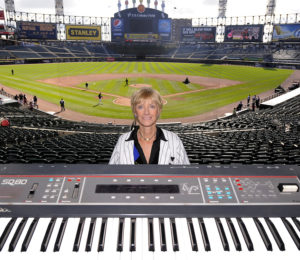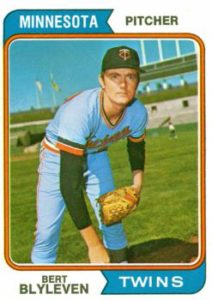 May 30, it turns out, is a (somewhat) historic day for Twins fans. On that date in 1992, 41-year-old Bert Blyleven (who would eventually enter the Baseball Hall of Fame under the bill of a Twins’ cap) toed the rubber for the California Angels (versus the Cleveland Indians). The right-hander, noted for one of the best curveballs in MLB history, threw seven innings of scoreless ball (three hits, two walks, seven strikeouts) and got the win as California prevailed 3-1.
May 30, it turns out, is a (somewhat) historic day for Twins fans. On that date in 1992, 41-year-old Bert Blyleven (who would eventually enter the Baseball Hall of Fame under the bill of a Twins’ cap) toed the rubber for the California Angels (versus the Cleveland Indians). The right-hander, noted for one of the best curveballs in MLB history, threw seven innings of scoreless ball (three hits, two walks, seven strikeouts) and got the win as California prevailed 3-1.
Why did this catch BBRT’s eye? First, I’m a big Blyleven fan. Second, Bert’s presence on the mound marked an unexpected comeback of sorts – he had missed the 1991 season recovering from rotator cuff surgery (and was 41, after all). Third, it was the first win of his final MLB season. But most important, it made Blyleven just the second pitcher to notch MLB victories as a teenager AND after age 40. (A third has since joined the list, but more on that later).
Pitchers with Victories as a Teenager and After Turning Forty
Herb Pennock … Bert Blyleven … Mike Morgan
Bert Blyleven
The “Dutchmaster’s” first MLB win, by the way, came in a Twins’ uniform, when the 19-year-old Blyleven made his MLB debut (June 5, 1970) against the Washington Senators (in D.C.). Young Bert went seven innings in that game, giving up one run on five hits and a walk, and fanning seven in a tight 2-1 Minnesota win. It was, of course, the first win of his first MLB season. Blyleven picked up nine more MLB wins before his 20th birthday (10-9, 3.18).
We’ve already looked at Blyleven’s first win after turning forty (first two paragraphs of this post) – which was the first tinw of his final MLB season. He did pick up seven more victories that campaign.
Blyleven’s Hall of Fame career covered 22 seasons (Twins, Rangers, Pirates, Indians, Angels) – 287 victories (250 losses); a 3.31 earned run average; 242 complete games; 60 shutouts; and 3,701 strikeouts. He was a two-time All Star and a 20-game winner in 1973.
Herb Pennock
 The first pitcher to earn MLB victories as a teenager and a 40-year-old was another Hall of Famer – Herb Pennock – whose career spanned from 1912 to 1934 (missing 1918 for military service). The southpaw’s first win came in the second game of a twin bill on June 28, 1912 – as his Philadelphia Athletics topped Washington 5-4 in ten innings. The 18-year-old Pennock came on in relief – pitching a scoreless ninth and tenth – for the victory. Pennock added two more victories (as a teenager) in 1913 – giving him a record of 3-3, 4.75 before his twentieth birthday.
The first pitcher to earn MLB victories as a teenager and a 40-year-old was another Hall of Famer – Herb Pennock – whose career spanned from 1912 to 1934 (missing 1918 for military service). The southpaw’s first win came in the second game of a twin bill on June 28, 1912 – as his Philadelphia Athletics topped Washington 5-4 in ten innings. The 18-year-old Pennock came on in relief – pitching a scoreless ninth and tenth – for the victory. Pennock added two more victories (as a teenager) in 1913 – giving him a record of 3-3, 4.75 before his twentieth birthday.
Pennock’s first win as a 40-year-old (he had two) came on May 20, 1934 – again in relief – as his Red Sox bested the White Sox 1-0. Pennock went 3 1/3 scoreless innings in that one, giving up one hit and one walk. The future Hall of Famer played 22 MLB seasons, going 241-162, 3.60 (37 saves), with 249 (410 starts) complete games and 37 shutouts. He was a two-time twenty game winner.
Mike Morgan
 The third pitcher to notch wins as a teenager and after age 40 was Mike Morgan – who, as a 18-year-old, was pushed out onto the major league mound by Oakland A’s owner Charlie Finley on June 11, 1978; less than a week after the A’s made the high schooler the fourth overall pick in the 1978 MLB draft. Despite going the distance in his debut (nine innings, three runs-two earned, five walks and no strikeouts), the teenager did not pick up the win. He got the loss as the A’s dropped a 3-0 decision to the Orioles. Morgan had to wait until July 29, 1979 for his first MLB win. On that day, the 19-year-old right hander picked up a 2-1 complete game win over the Seattle Mariners (three hits, one run, four walks and one strikeout). Morgan added a second win in his very next start (again over Seattle), but his overall record as a teenager was 2-13, 6.12. Morgan spent 1980 and 1981 in the minors before returning to the major leagues with the Yankees in 1982.
The third pitcher to notch wins as a teenager and after age 40 was Mike Morgan – who, as a 18-year-old, was pushed out onto the major league mound by Oakland A’s owner Charlie Finley on June 11, 1978; less than a week after the A’s made the high schooler the fourth overall pick in the 1978 MLB draft. Despite going the distance in his debut (nine innings, three runs-two earned, five walks and no strikeouts), the teenager did not pick up the win. He got the loss as the A’s dropped a 3-0 decision to the Orioles. Morgan had to wait until July 29, 1979 for his first MLB win. On that day, the 19-year-old right hander picked up a 2-1 complete game win over the Seattle Mariners (three hits, one run, four walks and one strikeout). Morgan added a second win in his very next start (again over Seattle), but his overall record as a teenager was 2-13, 6.12. Morgan spent 1980 and 1981 in the minors before returning to the major leagues with the Yankees in 1982.
The victory that made Morgan a member of the under-twenty/over-forty winning pitchers’ club came on April 19, 2000. Morgan came into that game in the top of the eighth inning with his Diamondbacks tied at seven with the Rockies. He pitched a 1-2-3 inning and the Diamondbacks scored in the bottom of the frame to give Morgan the win (with relief in the ninth from Greg Swindell and Byung-Hyun Kim). Morgan added four more wins in 2000, one in 2001 and one in 2002.
For his 22-season career (A’s, Yankees, Blue Jays, Mariners, Orioles, Dodgers, Cubs, Cardinals, Reds, Twins, Rangers, Diamondbacks), Morgan was 141-186, 4.23 (8 saves) – appearing in 597 games (411 starts) with 46 complete games and 1,403 strikeouts.
FINAL TIDBIT – JUST IN CASE YOU ARE INTRESTED
Players with home runs as a teenager and after turning forty: Ty Cobb, Rusty Staub, Gary Sheffield, Alex Rodriguez.
Primary Resources: Baseball-Reference.com; Society for American Baseball Research
I tweet baseball @DavidBBRT
Follow/Like Baseball Roundtable’s Facebook page here. Blog post notifications, additional baseball commentary, prizes.
Member: Society for American Baseball Research; The Baseball Reliquary; The Negro Leagues Baseball Museum


